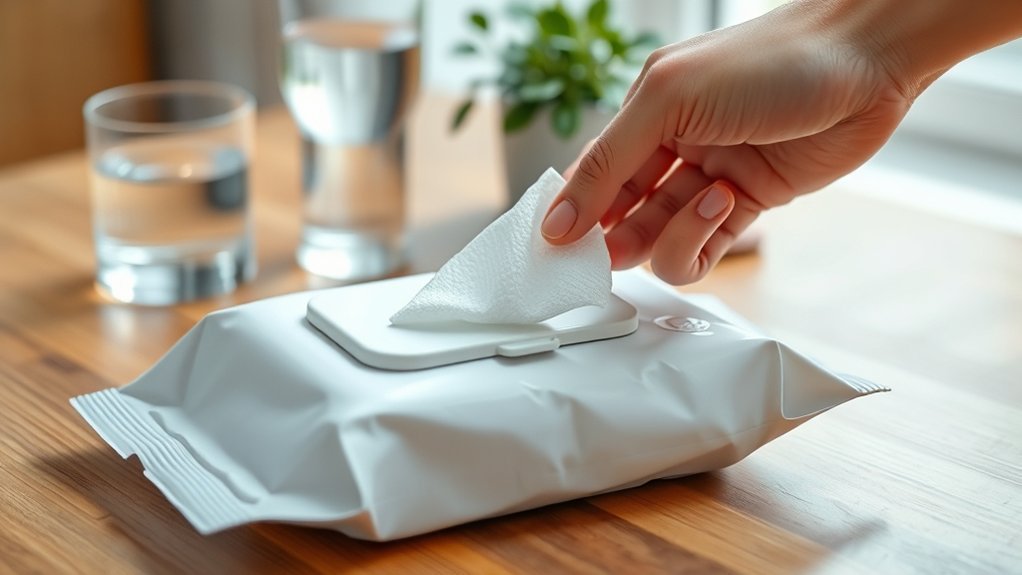Did you know that using wipes incorrectly can undermine their effectiveness and even pose health risks? To maximize their benefits, it’s vital to understand the do’s and don’ts associated with wipe usage. From following instructions to proper disposal methods, every detail counts. Let’s explore the best practices to guarantee you’re using wipes safely and effectively, while also considering the environmental impact. Your cleaning routine might just need a few adjustments.
Understanding Different Types of Wipes
When you’re choosing wipes, it’s essential to understand the various types available, as each serves a specific purpose.
You’ll encounter wipes made from diverse materials, including cotton, synthetic fibers, and biodegradable options. The choice of wipe material impacts both moisture retention and effectiveness.
For instance, cotton wipes excel in absorbing liquids, making them ideal for sensitive skin, while synthetic wipes are often stronger and more durable. Biodegradable wipes offer an eco-friendly option without sacrificing performance.
By considering the intended use—be it for cleaning, personal care, or disinfecting—you can select the right wipes to meet your needs.
Ultimately, understanding these distinctions empowers you to make informed choices that promote your well-being and environmental consciousness.
Key Do’s for Effective Wipe Usage
Selecting the right type of wipe is just the beginning; using them effectively is equally important. To guarantee effective application, always follow the directions on the packaging. This assures that you’re utilizing the wipes as intended, maximizing their cleaning power.
For surfaces, use a back-and-forth motion to lift dirt and germs more efficiently.
After use, proper disposal is vital. Don’t flush wipes, even if they claim to be flushable; instead, toss them in the trash. This helps prevent clogs and protects our waterways.
Additionally, consider using wipes in areas where water isn’t readily available, enhancing your cleaning routine without compromising the environment. By following these do’s, you’ll harness the full potential of your wipes while fostering a cleaner, healthier space.
Common Don’ts to Avoid
While it’s tempting to think all wipes are created equal, there are several common pitfalls you should steer clear of to guarantee ideal cleaning results.
First, avoid improper wipes storage; keeping them in humid areas can cause them to dry out or become contaminated.
Avoid storing wipes in humid areas to prevent drying out or contamination. Proper storage is key to effective cleaning.
Second, don’t use wipes beyond their intended purpose; they’re designed for specific tasks, and misusing them can lead to ineffective cleaning.
Additionally, make certain proper wipe disposal; flushing wipes can cause plumbing issues, so always throw them in the trash.
Finally, resist the urge to reuse wipes, as this can spread germs instead of eliminating them.
Wipe Safety and Environmental Considerations
Understanding wipe safety and environmental considerations is vital for making informed choices. You should prioritize biodegradable options, as these are designed to break down naturally and reduce landfill waste. Additionally, scrutinizing chemical ingredients is essential; some wipes contain harmful substances that can affect both health and the environment.
Here’s a quick comparison to guide your decision:
| Consideration | Importance |
|---|---|
| Biodegradable Options | Minimize environmental impact |
| Chemical Ingredients | Guarantee safety for you and the planet |
Selecting the Right Wipes for Your Needs
When it comes to choosing the right wipes for your needs, several factors play an important role in ensuring you make the best choice.
First, consider the purpose; for cleaning your baby, opt for gentle, hypoallergenic baby wipes that won’t irritate sensitive skin. If you’re tackling germs, disinfectant wipes are essential for effectively sanitizing surfaces.
Check the ingredients; look for wipes free from harsh chemicals, especially if you’re using them around children or pets.
Also, think about convenience—packaging that allows for one-handed use can be a game-changer.
Finally, consider the environment; biodegradable options are a responsible choice.
Frequently Asked Questions
Can Wipes Be Used on All Surfaces?
Wipes aren’t suitable for all surfaces. Consider surface compatibility and material considerations; some fabrics or finishes might be damaged. Always check manufacturer guidelines to guarantee you’re using wipes safely and effectively on various materials.
Are There Wipes Specifically for Sensitive Skin?
Yes, there are wipes specifically for sensitive skin. Look for hypoallergenic options to minimize the risk of skin irritation. These gentle wipes can help you feel liberated and confident in your daily routines.
How Long Do Wipes Remain Effective After Opening?
Wipes generally remain effective for about 2-3 months after opening. Follow expiration guidelines and store them in a cool, dry place to maintain moisture and prevent contamination. Always check for signs of deterioration before use.
Can I Flush All Types of Wipes?
Can you really flush all types of wipes? No, many aren’t designed for flushing and can cause plumbing issues. Proper wipes disposal is essential to reduce environmental impact and keep our waterways clean.
What Ingredients Should I Avoid in Wipes?
You should avoid wipes containing harsh chemicals, fragrances, and parabens. Instead, opt for paraben-free options and alcohol-free alternatives to guarantee a gentler, safer experience for your skin while maintaining effective cleanliness.
Conclusion
In summary, using wipes effectively can make your cleaning routine as smooth as a well-oiled machine. By following the do’s and avoiding the don’ts, you can guarantee a thorough clean while keeping germs at bay. Remember to choose the right wipes for your specific needs and consider safety and environmental factors. With these guidelines in mind, you’ll not only enhance your cleaning efforts but also create a healthier living space for you and your loved ones.
